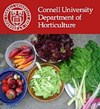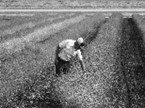Posted 7/21/2011
Keith Tidball, a senior extension associate in the Department of Natural Resources at Cornell and the coordinator for the New York State Extension Disaster Education Network, has compiled a list of articles and resources from extension services across the country to help protect farm animals from the heat.
Tidball provides general advice from the Illinois Extension which says "...for production animals we caution that they be given plenty of fresh water, shade and ventilation. If a four-legged farm animal refuses to eat, is salivating excessively, exhibits labored breathing or has convulsions the vet should be called and the animal bathed in cool water starting at the ribs and working the way down the legs." (Rick Atterbery)
Farm animal resources:
For dairy cattle: the University of Arkansas Extension's Heat Stress in Dairy Cattle
For beef producers: the University of Ohio Extension’s Heat Stress and Beef Cattle
For small ruminants: the University of Maryland’s Heat stress in sheep and goats
For swine: the University of Minnesota Extension’s Minimizing Heat Stress in Pigs During the Summer
For broilers: the University of Florida Extension’s Heat Stress Management in Broilers
Also check out the USDA’s Heat stress forecasts - Livestock.
Posted 7/13/2011

The Cornell Maple Program is offering a unique opportunity for maple producers to acquire hands-on experience to increase production, profitability and efficiency.
The Cornell Maple Camp will begin late afternoon on August 25 and conclude at noon on August 28. The Cornell Maple Camp will be held at Cornell’s Arnot Teaching and Research Forest just outside Ithaca.
In the sugarbush, participants will learn how to measure and select trees, how to evaluate, plan and install a tubing system, and how to evaluate vacuum and bucket systems for efficiency.
In the sugar house participants will learn about sap storage, reverse osmosis, evaporator operations, and syrup filtering, storage and grading.
Further, participants learn to understand the principles of marketing syrup and value added products, making value-added products, and evaluating and managing their business enterprise.
Registration information is available by going to www.CornellMaple.info and selecting Cornell Maple Camp. Registration including all meals (Thursday supper through Sunday lunch) and handouts are $90 per person. Cabins at the Arnot Forest will be available for rent at $90 per person for the complete stay (Thursday, Friday and Saturday nights) or information on local hotels can be provided. This training is sponsored by the Cornell Maple Program and the New York State Farm Viability Institute.
Posted 7/11/2011
Here’s another installment of the new Capital Area Agricultural & Horticulture Program’s Capital Region agriculture reports. This edition includes comments on crops and soils, articles from the state Integrated Pest Management program and a calendar of events.
Posted 7/8/2011
Join the Capital District Vegetable and Small Fruit Program staff next Wednesdy as they tour Amos Yoder’s farm with Dr. Thomas Zitter of Cornell University and discuss diseases and insects and how to control them. Growers will have the opportunity to ask questions and are encouraged to bring samples in SEALED Zip-Loc bags for Zitter and vegetable program staff to examine.
The program begins at 10 a.m.at Yoder’s Produce, 463 Argersinger Road, Fultonville. The program is free.
For more information contact Extension Specialist Crystal Stewart at 775-0018.
Posted 6/23/2011
The new Capital Area Agricultural & Horticulture Program has begun putting together weekly Capital Region agriculture reports.
This week’s edition features weather data, a report from the New York State Integrated Pest Management Program, an article on crops and soil and a calendar of events.
To read the June 22 Capital Area Ag Report download the file below.
Posted 6/14/2011

The Extension Master Gardener blog today reminds gardeners of a great resource available for free from Cornell University. “Vegetable Varieties for Gardeners (VVfG) takes the guesswork out of selecting vegetable varieties for your garden, providing an avenue for gardeners across the country to connect and share their experiences growing myriad hybrid, open pollinated varieties, and heirloom varieties,” the blog says.
The Vegetable Varieties for Gardeners resources are free. Users will have register to have access to all the features. On the site gardeners can read reviews written by the over 5,000 registered users. Users can plug in their locations and personal preferences to find vegetables that are a good match for them. There also links to other Cornell gardening resources and fact sheets, including vegetable growing guides.
To learn more read the Extension Master Gardener blog post Vegetable Varieties for Gardeners: An Indispensable Tool or visit Vegetable Varieties for Gardeners website directly. You can also find Vegetable Varieties for Gardeners on Facebook.
Posted 6/6/2011
CCE has developed a series of four workshops that will teach the basics of strategic marketing, including how to identify a target market and focus a farm’s marketing efforts. Participants will also learn how to choose the markets that meet the needs of your farm, such as CSA, farmers’ market and wholesale. Each participant will develop components of a marketing plan and create marketing materials. While this series is tailored specifically to the marketing of meats and other livestock products, it will benefit any farm looking to improve their marketing efforts.
Each session runs from 6:30-8:30 p.m.
Session 1, July 6: Introduction to Strategic Marketing: Identifying a Target Market
Session 2, July 13: Communicating with Customers
Session 3, July 20: A Guide to Marketing Channel Selection
Session 4, date varies by location: Review and Critique of Your Marketing Materials
Locations:
CCE-Ontario County, contact 585-394-3977 x 427 or email Nancy Anderson nea8@cornell.edu.
CCE Saratoga County, contact: 518-885-8995 or email Paula Schafer at pjb11@cornell.edu
Posted 5/20/2011

The Cornell Department of Horticulture blog today offers “10 tips for gardeners to beat late blight.”
Earlier this week, state Agriculture Commissioner Darrel J. Aubertine alerted gardeners and commercial growers of the possibility of late blight again this year.
“The exceptionally cool, damp spring we are experiencing throughout New York State this year heightens our concern for late blight,” Aubertine said in a news release. “We saw the devastation it can do to a tomato crop in 2009, and we have already received reports of early late blight detection in neighboring states.”
While late blight has not been detected in New York at this time, it has been detected in Michigan, Connecticut and Maine.
“Last year, the Department initiated a concerted strategy to enhance the State’s detection and eradication efforts that involved training its horticultural inspectors, surveying plants at the retail level and in commercial greenhouses, and working with Cornell Cooperative Extension to conduct outreach and follow up in the field with growers and gardeners,” the Ag and Markets news release said. “This year, inspection of tomato plants has been a priority, and to date, more than 150,000 tomato plants have been inspected with no signs of late blight detected.”
The Cornell Horticulture blog offers the following 10 tips for gardeners to beat late blight:
Kill volunteer potatoes. Dig up, bag and trash any potato plants that pop up in your garden or compost pile. It may take repeated efforts to get them all.
Buy healthy tomato plants. Learn what late blight looks like. If you spot any infected plants while shopping, alert store management and your local Cooperative Extension office, and buy your plants somewhere else. Or you can grow your own plants. (Late blight isn’t spread on tomato seeds.) Start seed about 6 to 8 weeks before your last frost date.
Posted 5/17/2011
The Central New York Dairy and Field Crops Team has announced they, together with the Cornell Cooperative Extensions in Chenango, Herkimer, Madison, Otsego and Schoharie counties, “will be monitoring first cutting hay fields this spring to help suggest when producers should begin cutting for the highest quality forage for producing milk.”
“Alfalfa height has been shown to be a strong predictor of in-field NDF (Neutral Detergent Fiber) and gives a reasonable indication of forage quality without the need of forage testing. It has been shown that alfalfa height can not only predict alfalfa NDF but also the NDF content of mixed alfalfa grass stands and pure grass stands,” a May 16 communication from the Dairy and Field Crops Team said.
The Dairy and Field Crops Team has provided a First Cutting Forage Quality Update containing alfalfa height measurements and predicted NDF values for fields in Chenango, Fulton, Herkimer, Madison, Montgomery, Otsego and Schoharie counties.
The Dairy and Field Crops Team intends that this information provides encouragement for farmers to check their own fields so that they are aware of whether or not they should be harvesting.
“There are considerable differences in maturity depending geographic location, elevation, soil drainage and which direction the slope is facing. Fields that are in some combination of south facing, well drained and in the valley are much further along. We cannot emphasize enough you need to check your fields!” the Dairy and Field Crops Team notice announcing the forage update said.
Posted 5/9/2011
The New York Farm Service Agency (FSA) is asking farmers to contact them immediately if adverse weather has delayed planting or damaged their crops.
Producers must report the acreage to FSA within 15 days of the final planting date of the crop.
Final planting dates are as follows:
May 10 Oats, spring barley, spring seedlings, onions
May 20 Peas
June 10 Corn, soybeans, potatoes
June 30 Dry beans
July 20 Green beans
Aug. 30 Fall seedling
Sept. 30 Winter barley
Oct. 10 Wheat
The requirement applies to all crops, whether covered by crop insurance, not covered by crop insurance, or covered by FSA's Non-insured Assistance Program.
For more information about reporting prevented planting or failed acres, contact your local FSA county office or visit www.fsa.usda.gov.






